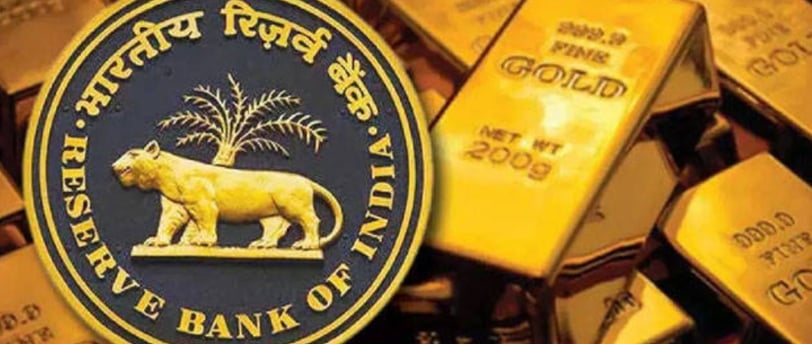Add your promotional text...
Gold Rush: How the Reserve Bank of India is Strengthening Its Reserves in 2024
Synopsis: As central banks globally ramp up gold purchases, the Reserve Bank of India (RBI) has emerged as a significant player, adding eight tonnes of gold in November 2024 alone. This move reflects a broader strategy to hedge against inflation and reduce foreign currency risks amidst geopolitical uncertainty.
VIEWS ON NEWS
By Monika Agarwal
1/7/20253 min read


RBI Ramps Up Gold Accumulation Amid Global Central Bank Buying Spree
Gold remains a preferred asset for central banks worldwide, and November 2024 showcased a continued trend of large-scale purchases. According to the latest World Gold Council (WGC) report, global central banks collectively added 53 tonnes of gold to their reserves during the month, with the Reserve Bank of India (RBI) contributing significantly by acquiring eight tonnes.
This purchase brought the RBI’s total gold acquisitions in the first 11 months of 2024 to an impressive 73 tonnes, taking its total reserves to 876 tonnes. The move aligns with a global strategy of central banks to increase gold holdings as a safe-haven asset amidst volatile economic conditions.
Why Central Banks Are Buying Gold
Central banks across the globe have been actively accumulating gold for several strategic reasons:
Hedging Against Inflation: Gold has historically been a reliable hedge against inflation, making it an essential component of reserve portfolios during periods of rising prices.
Reducing Currency Risks: In the face of geopolitical uncertainties, gold serves as a stable reserve asset, mitigating the risks associated with volatile foreign exchange markets.
Diversification of Reserves: Gold’s intrinsic value and lack of credit risk make it a valuable asset for diversifying reserves, especially when compared to fiat currencies.
The WGC report highlighted that a decline in gold prices following the U.S. elections in November may have provided central banks with an opportune moment to accumulate the metal.
RBI’s Growing Gold Reserves: Key Insights
Unprecedented Growth in 2024
The RBI’s gold purchases in 2024 represent a five-fold increase over the same period in 2023. By the end of November, its total gold reserves stood at 890 tonnes, of which 510 tonnes are held domestically. This strategic accumulation reinforces the RBI’s commitment to strengthening its reserves.
Position Among Global Buyers
In 2024, the RBI emerged as the second-largest buyer of gold, trailing only Poland, which added 21 tonnes in November. Uzbekistan also contributed significantly, purchasing nine tonnes during the month.
Meanwhile, China’s central bank, the People’s Bank of China (PBoC), resumed gold acquisitions after a six-month hiatus, adding five tonnes in November to bring its total holdings to 2,264 tonnes, equivalent to 5% of its total reserves.
Gold Reserves: Where Does the RBI Store Its Wealth?
The RBI’s gold reserves are strategically distributed across domestic and international locations:
Domestic Storage: Approximately 510 tonnes are securely stored in India, with vaults in Mumbai and Nagpur playing a crucial role.
Overseas Custody: More than half of the RBI’s reserves are held overseas, primarily with the Bank of England and the Bank of International Settlements.
In 2024, the RBI took a significant step by repatriating 100 metric tonnes of gold from UK bank vaults to India, citing sufficient domestic storage capacity. This move not only enhances national security but also reduces the high fees previously incurred for overseas storage.
Global Trends in Central Bank Gold Activity
Poland Takes the Lead
Poland has been a major buyer in 2024, adding 21 tonnes of gold in November alone. This aggressive accumulation underscores the strategic importance of gold for economic resilience.
China’s Gold Strategy
China’s PBoC resumed its gold purchases in November after a hiatus, acquiring five tonnes to reach 34 tonnes in net purchases for the year. This highlights China’s intent to maintain a robust reserve portfolio in light of its growing economic influence.
Singapore’s Diverging Approach
Contrary to the buying trend, the Monetary Authority of Singapore reduced its gold reserves by five tonnes in November, marking year-to-date net sales of seven tonnes and lowering its total holdings to 223 tonnes.
Gold Prices and Central Bank Influence
The large-scale gold purchases by central banks have had a noticeable impact on global gold prices. While the November dip in prices provided a buying opportunity, sustained demand has historically driven up the metal’s value. As central banks continue to prioritize gold, its role as a key asset in reserve portfolios is further solidified.
The Broader Implications of RBI’s Strategy
The RBI’s consistent focus on increasing gold reserves reflects a forward-looking approach to economic stability. By bolstering its gold holdings, the RBI is:
Mitigating Risks: Safeguarding against potential disruptions in global financial markets.
Enhancing Resilience: Strengthening India’s economic framework amidst global uncertainties.
Building Public Confidence: Demonstrating the central bank’s commitment to sound financial management.
What Lies Ahead?
As global central banks, including the RBI, continue their gold buying spree, the precious metal is expected to remain a cornerstone of reserve management. With economic uncertainties, inflationary pressures, and geopolitical tensions persisting, gold’s appeal as a safe-haven asset is unlikely to diminish.
For India, the RBI’s strategic gold acquisitions signal a commitment to long-term economic stability, ensuring that the country is better equipped to navigate future challenges. The move also reinforces the central bank’s pivotal role in securing India’s financial future.
